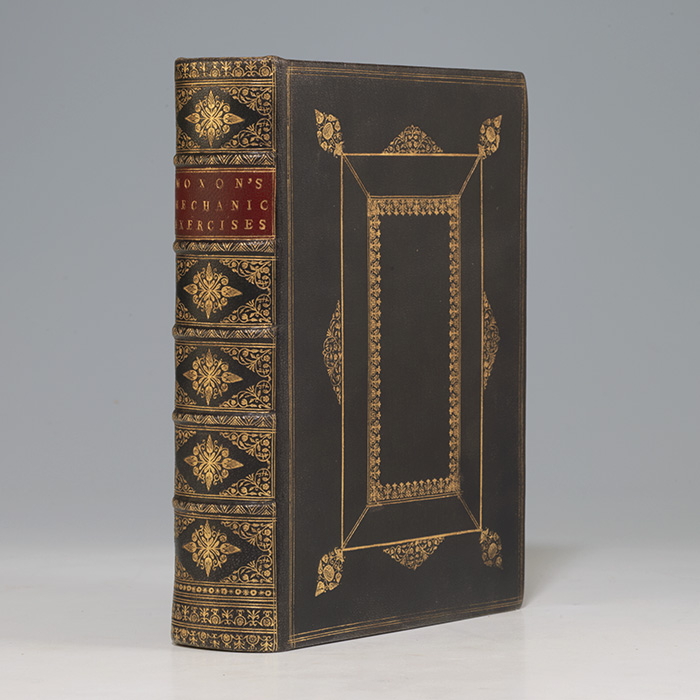
"THE EARLIEST MANUAL, IN ANY LANGUAGE, OF THE PRINTING TRADE": JOSEPH MOXON'S VERY RARE MECHANICK EXERCISES, 1683-84 FIRST EDITION, WITH ENGRAVED ILLUSTRATIONS
(PRINTING, et al.) MOXON, Joseph. Mechanick Exercises, or the Doctrine of Handy-Works. London: Joseph Moxon, 1683[-1684]. Two volumes bound as one. Quarto, period-style full black morocco, elaborately gilt-decorated spine and boards, red morocco spine label, raised bands, marbled endpapers. $12,000.
Rare first edition of Moxon's guide to the chief trades of his day, with the all-important second volume devoted entirely to the printing trade, the first such manual published in any language—as well as the first English book to describe ink making—illustrated with 49 (of 60) engraved plates, 25 of which relate to the printing trade. Issued in parts, "very few complete sets have been preserved, the work being, perhaps, the most difficult to obtain in the whole range of typographical literature" (Bigmore & Wyman). In this copy, the volume on printing was bound without one part only—the three numbers on letter-cutting—and thus wants 48 pages from the total of 394 and ten plates from the total of 35, but includes complete chapters and their accompanying illustrations on printing, the construction and functions of the press, mold-making and the casting of letters, the duties of compositors, correctors, pressmen, and warehouse-keepers, and includes a lengthy dictionary of terms at the end.
"This was the earliest manual, in any language, of the printing trade. Moxon provided detailed technical accounts of the tools of the compositor and the pressman, the art of typefounding, and the work of the compositor, corrector, pressman and other members of the printing trades as they had come down to his day; most of these had not changed materially for nearly two hundred years, and would remain unaltered until the mechanization of printing in the 19th century… It was copied by virtually every writer of printing manuals and served as a standard text for over two hundred years" (Norman). "Moxon's election to the Royal Society in November 1678 is remarkable for the fact that he was the first tradesman to join the fellowship, a precedent not repeated during the 17th century. As hydrographer royal and as a printer and publisher, he had a reputation long known to many fellows. His election is probably linked to the January 1678 publication of the first part of Mechanick Exercises… His most famous work, Mechanick Exercises… Applied to the Art of Printing, [was] published in 24 numbers in 1683-84. Here he details all aspects of printing techniques of his day, capturing for posterity the unrecorded tacit craft skills… It is the precise record of the printing trade seen through the eyes of a practitioner" (ODNB).
Moxon's Mechanical Exercises were intended to describe the chief trades of the day, issued in monthly numbers, each number consisting of 16 pages and one or more engraved plates. Volume I, which contains sections on smithing, joinery, house-carpentry, and turning, was originally published in 14 parts between 1677 and 1680. The second volume, concerned solely with printing, was published in 1683, delayed, as Moxon explains in his Advertisement, "by the breaking out of the [Popish] Plot, which took off the minds of my few Customers from buying them." (A third section, describing bricklaying, published by Moxon's son James, is bound in at the end of Volume I, with a title page dated 1700 and seven engraved plates.)
Throughout the fine engraved plates show tools, furnaces, locks, wainscoting, and machines. In the printing volume the plates depict compositors' cases and their lay, composing sticks, galleys, printing presses and their separate parts, punchcutters' tools, casting tools, imposition, wetting and drying the sheets, knocking up the balls, pressing the piles. Curiously, on sheet Ddd in the volume on printing a single piece of type had strayed or fallen onto the outer forme and a clear impression of its shank and beard can be seen in the lower outer blank corner of Ddd4v.
Volume II, on Printing, bound without one part, comprising Numbers 7-9, on Letter-Cutting (signatures N-S; pp. 81-128) and plates 10-17; also without the two engraved frontispieces, portraits of Gutenberg and Coster, noted in the Norman copy. At the Norman sale it was noted that this book is "rarely found complete." "Although 500 copies were printed, very few complete sets have been preserved, the work being, perhaps, the most difficult to obtain in the whole range of typographical literature" (Bigmore & Wyman). Volume I without engraved frontispiece. This copy contains the section on bricklayers, published separately in 1700 by Moxon's son James, with seven engraved plates—not present in the Norman copy. Norman notes that in Volume I, 14 numbers were issued between 1677 and 1680, making this "the first book in England to be published in parts." When Moxon resumed the book in 1683 to produce the volume on printing, he issued a general title page for the first volume, bearing the 1683 date (as here), and reprinted the first three numbers only—as these early numbers had sold out—with dates of 1683, 1683, and 1684 on their respective title pages. This copy (as does the Norman copy) contains the original third number, with the imprint date of 1677. Wing M3013, M3014. Norman Library of Science and Medicine 1561. Bigmore & Wyman II, 54.
Plate 11 in Volume I with expert paper repair. Occasional light soiling to a few text leaves, occasional faint foxing. A beautifully bound, near-complete copy of this very scarce and important work.